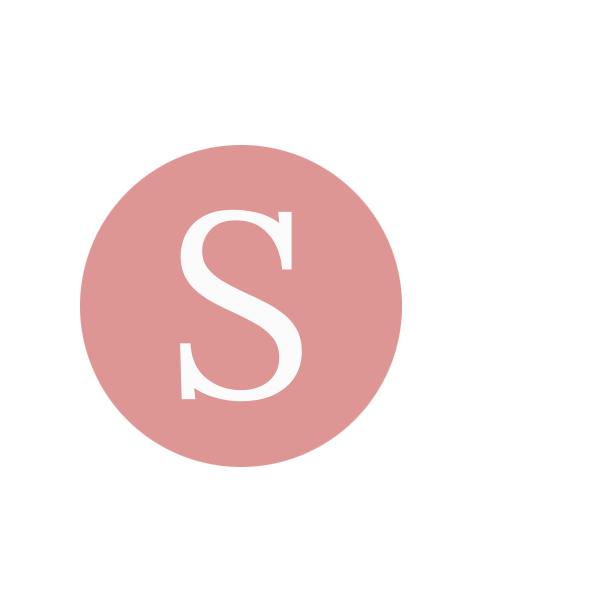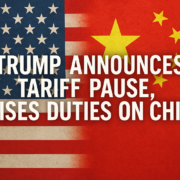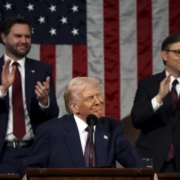Economic Warning Signs: Is a Recession Closer Than We Think?
The numbers don’t lie, but they don’t always tell the whole story either. President Trump’s recent policy moves have economists scrambling to determine whether the U.S. economy is running on solid ground—or a house of cards stacked against a gusty political wind. On paper, the fourth quarter’s 2.3% GDP growth and a January unemployment rate of 4% look respectable. But scratch beneath the surface, and a less reassuring picture emerges: consumer spending—the lifeblood of the economy—fell by 0.2% in January, marking its steepest decline in four years. That drop, coupled with a significant dip in consumer confidence, has analysts wondering whether we’re approaching the crest before a long slide downward.
Economic Warning Signs: Consumer Spending Decline and Market Reactions
While Wall Street bulls might point to the economy’s overall stability, a closer look at key indicators suggests that the outlook isn’t as rosy as it seems. The S&P 500 has been taking hits, and 10-year Treasury yields have slumped, reflecting market jitters over looming uncertainties. Federal employment cuts and the administration’s continued tariff brinkmanship are rattling corporate planners and financial analysts alike.
Economists are increasingly sounding the alarm. Estimates now peg the probability of a recession in the next year at 35% to 40%. That’s not doomsday prophecy, but it’s a stark reminder that economic expansion cycles don’t last forever—especially when policymakers seem intent on stress-testing the system with erratic decision-making. As one senior economist from the Brookings Institution put it, “Markets can handle risk, but what they struggle with most is uncertainty. Right now, we’re dealing with a self-inflicted wound of unpredictability.”
U.S. Trade Policy and Federal Job Cuts: High-Risk Economic Strategies
Much of the unease stems from a two-pronged policy push—threatened tariffs and reductions in federal employment. The administration’s tough-on-trade rhetoric has already made waves, with businesses from manufacturing to agriculture feeling the squeeze of supply chain disruptions and retaliatory tariffs from trading partners. Meanwhile, government job cuts threaten to erode a key source of economic stability, as federal paychecks fuel spending in many regions that depend on government employment.
Some administration officials argue that tariffs are necessary to recalibrate America’s trade imbalances, but critics counter that the collateral damage could outweigh the gains. “The problem with tariffs is that they tend to hit the consumer hardest,” said a senior policy analyst at the Peterson Institute for International Economics. “And when consumer spending accounts for nearly 70% of GDP, it’s not a lever you want to pull recklessly.”
This policy mix isn’t just an economic gamble—it’s a high-wire act without a safety net. Consumer sentiment, the most crucial determinant of economic activity, is showing the strain. Confidence levels just took their worst dive since 2021, suggesting that Americans are tightening their belts in anticipation of harder times ahead. When consumer spending falters, it’s a domino effect: businesses cut back, hiring slows, and economic growth stalls.
Stock Market Volatility and Bond Yields: Investor Confidence Shaken
The markets have picked up on the uncertainty. The S&P 500’s recent slide reflects investor skepticism over the sustainability of growth under the weight of unpredictable policy moves. The drop in 10-year Treasury yields further signals a flight to safety, as bond investors hedge against potential turbulence.
To be clear, this isn’t 2008. But it’s not 2017 either. The warning signs are flashing, and ignoring them won’t make them disappear. Whether the administration course-corrects or doubles down on these policies could determine whether the next economic chapter is one of continued expansion or an impending contraction.
Investment Strategies to Navigate Economic Uncertainty
In times of economic uncertainty, investors, businesses, and consumers must take proactive steps to protect their financial well-being. Here are some strategic moves to consider:
- Diversify Investments – Reducing exposure to volatile stocks by incorporating bonds, commodities, and recession-proof sectors (such as healthcare and utilities) can provide stability.
- Hold More Cash Reserves – Increasing liquidity ensures that individuals and businesses have the flexibility to navigate market downturns.
- Focus on Dividend Stocks – Companies with a strong dividend history often perform better during economic slowdowns.
- Monitor Policy Changes Closely – Understanding shifts in trade policies, interest rates, and employment regulations can help businesses and investors make informed decisions.
- Consider Defensive Sectors – Consumer staples, energy, and gold tend to hold value better during market turbulence.
While no strategy can fully eliminate risk, a balanced and well-informed approach can help investors and businesses weather economic storms more effectively. The coming months will be a crucial test of economic resilience, as markets react to shifting policies and global uncertainties. Those who stay informed, diversify wisely, and adapt to evolving conditions will be best positioned to navigate potential downturns.
Whether the economy stabilizes or slides into a recession will depend on key policy choices and market responses. Investors and businesses must remain vigilant, ready to adjust strategies in an unpredictable financial landscape. As one Wall Street strategist put it, “Investors don’t mind risk—but what they hate is chaos. And right now, the administration is serving it up in heaping portions.”







Leave a Reply
Want to join the discussion?Feel free to contribute!